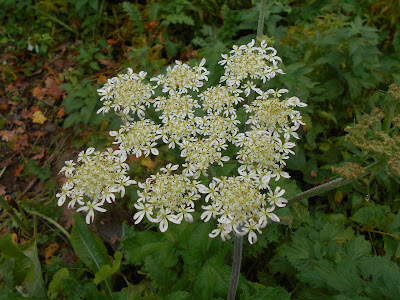Hogweed Hotel was open for business but was receiving few visitors. Can't blame them, for any nectar would be greatly diluted by the overnight rain but basically insects, being ectothermic creatures, need the warmth of the sun to lift them from their overnight torpor.
 |
No takers today. The hogweed, so popular with insects, was free of
visitors. Byfield Pocket Park, 6 November, 2019
|
It was a day for birds, and had I brought my binoculars I could have noted a number of species. So far the autumn has been easy for birds, with shrubs and herbaceous plants still bearing heavy crops of fruit, as yet unrequired.
Tutsan, Hypericum androsaemum, was covered in fruit, but in truth these will not currently attract birds. The fruit will eventually split and expose the seeds upon which birds, particularly bullfinches, will feed. Tutsan is an odd sort of name and is apparently derived from the French toute-saine - meaning 'all-heal' and the plant once had a reputation as a healing plant. Rather oddly perhaps, tutsan leaves were once traditionally used as bookmarks, particularly for bibles. The hypericums are otherwise known as St. John's Worts.
 |
One the fruit have split open these tutsan fruits may attract seed-eating
birds. Byfield Pocket Park. 6 November, 2019
|
Also untouched were the berries of Guelder Rose,Viburnum opulus. The specimen I photographed is the yellow-fruited form, 'Xanthocarpus', and birds such as mistle thrushes may eventually feed upon them.
Beech leaves were bearing a number of leaf mines and I must make a return trip to photograph and gather a few examples, but for today I contented myself with Acalitus stenapsis, a mite which had caused the development of a neat roll along the leaf edges. It was not a new record for the site and is indeed common over the whole of southern Britain.
The word 'Gladwyn' is an old name for sword and refers rather obviously to the leaves. This unusual iris is rather uncommon as a genuinely wild plant but has found a congenial home in churchyards and on roadsides. I am always pleased to find it but I tend to leave it alone: it has a reputation as a very strong laxative!
 |
Neatly edged beech leaves, the work of a mite, Aculitus stenapsis.
Byfield Pocket Park, 6 November, 2019
|
I had sprung a leak in my footwear and so I headed back to meet Chris and friends at the Coffee Club, but I could not resist photographing some primroses on a grassy bank. These are undoubtedly the Common Primrose, Primula vulgaris, but presumably a selected strain for autumn flowering.
 |
Yes, primroses flowering in autumn. But by so doing they will miss
pollinators such as the Dark-edged Bee Fly. Brightwell Playing Fields,
Byfield. 6 November, 2019
|
And finally, just before reaching my goal of the Village Hall, a specimen of Gladwyn, or Stinking Iris, Iris foetidissima, had to be pictured. As I have mentioned before, its berries seem not to be relished by birds but, given a wintry spell of weather, there may be some takers. In fact there are plants scattered around the village and this may be the result of birds distributing the seeds through their faeces.
 |
Stinking Iris, Gladdon, Gladwyn, Roast-beef Plant. There are plants
scattered all around Byfield. 6 November, 2019
|
No comments:
Post a Comment